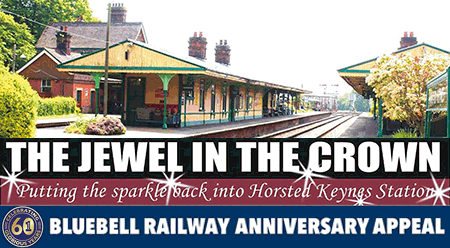

|


|

|
|
Locomotives - Operational Locos - Locos under overhaul - Locos on static display - Locos formerly based on the Bluebell Loco Roster - Loco Stock List - Loco Works News - Join the Loco Dept 

Bluebell Railway Villa TeamFenchurch's Cylinders
When Fenchurch's repair started we had no reason to suspect that there was any particular problem with the cylinders, other than that several of the old engines with inside cylinders have suffered corrosion from the top of the casting downwards, caused by condensation in the smokebox mixing with the ash to make an acid solution which leached through cracks in the concrete floor to attack the cylinder casting itself. Stepney, Birch Grove, and 1178 have all suffered from this, the two smaller engines each having holed through into one of the cylinder barrels; this was repaired with a metal filler, and in Stepney's case enabled it to run for nearly 10 years. The problemsThe first problem with Fenchurch's cylinders was found whilst preparing to remove the boiler from the frames, during removal of the some of the concrete which forms the floor of the smokebox, in order to get at the bolts holding the smokebox to the frames. The powered hammer used broke through the exhaust manifold a few inches below the blastpipe, where the casting had corroded down to zero thickness of metal. After the boiler had been removed, the rest of the concrete was removed from the cylinders, showing that there were three serious problems.
The third problem became known when the top of the right casting was cleaned of concrete and rust down to solid metal. With no steam pipe connection, the right casting has a large part of the barrel wall exposed to the concrete. In the centre of this part the barrel wall was found to be only 3/16in thick; originally it was 1 1/4in. The cylinders were removed from the frames and split apart. It is possible to repair all three faults, but it was decided that making a new set of cylinders would be the most satisfactory repair. This decision was influenced by the poor condition of Stepney's cylinders, and the fact that the other five potentially working Terriers are all in or heading for the same sort of condition. New cylindersOur master pattern-maker Brian Wilkie, fresh from his triumph with the new wheels, was prevailed upon to undertake the making of a pattern for casting the new cylinders. This is an altogether different proposition - a much more complex casting. The two sides are different, with few interchangable parts. Several major parts of the pattern assembly have been made. Click here for details. Brian and his assistant Roy Stirling have been working on the pattern for past two years, and have made considerable progress. [More about this will appear here when I've taken some pics.] Repairing the old cylindersWhen the decision to make new cylinders was taken, it was in the knowledge that on the old ones the barrels and valve faces were in very good condition, and this would therefore be wasted. Recently, a re-evaluation of the job has brought the conclusion that, whilst new Terrier cylinders will be required at a not very distant date, in Fenchurch's case it would be much quicker to rerpair the old ones. So, the current plan is that the making of the casting patterns for new cylinders will go ahead, and meanwhile the old cylinders will be examined by our full-time machinist Ray Bellingham with a view to replacing the top parts of the casting with a fabricated section where the main steam pipe and the blastpipe bolt on. Anyone got a spanner that fits this ?
Return to the Fenchurch Page 

Return to BRPS Home Page, to the Timetable or to Special Events
Current Loco Works News - Recent Archive News - 1997-2003 Archive News - Villa Team Pictures
Visitor Info. - Museum - Trust - Catering - Contacts - What's New - Projects - Locos - Carriages & Wagons - Signals - History - Other - Links - Search - FAQ Why not become a BRPS Member? - Get more involved as a Volunteer © Copyright BRPS. Privacy Policy |
![[View of cylinders after removal]](976_017_hs.jpg)
![[View of right exhaust manifold]](978_008_hs.jpg)
![[View of main steam pipe flange on cylinder]](978_010_hs.jpg)
![[View of 5-sided nut]](978_023_hs.jpg)